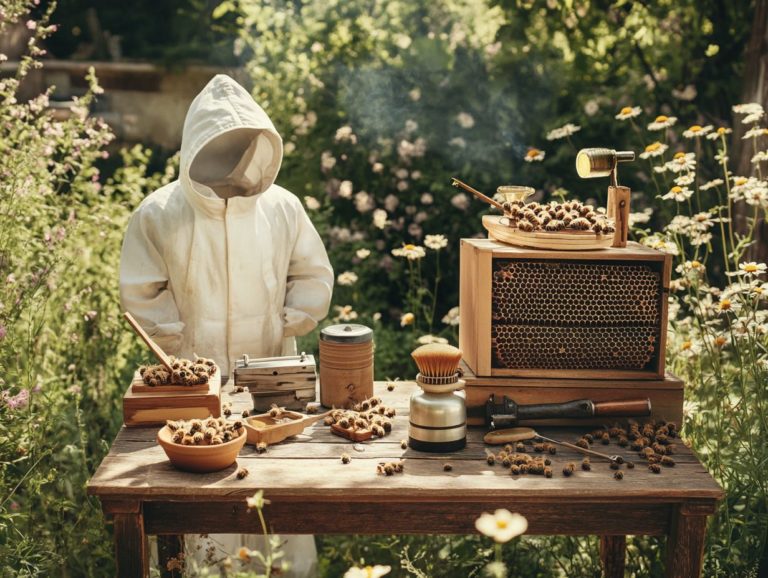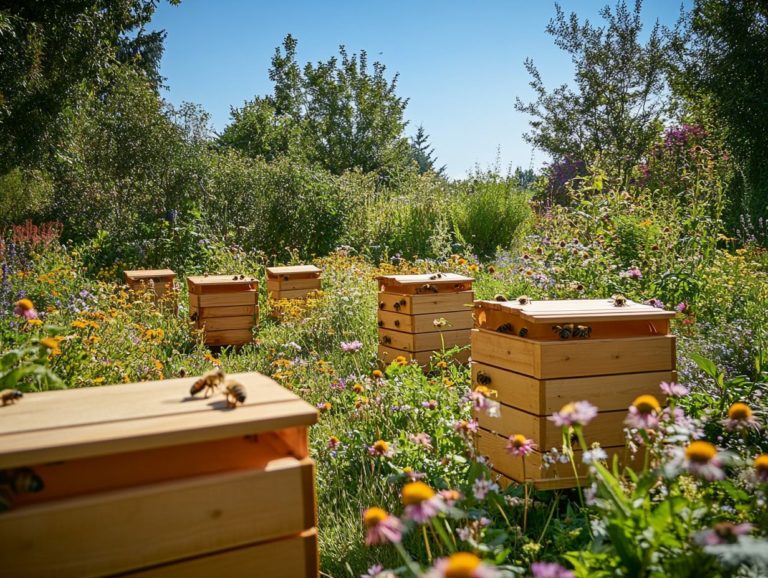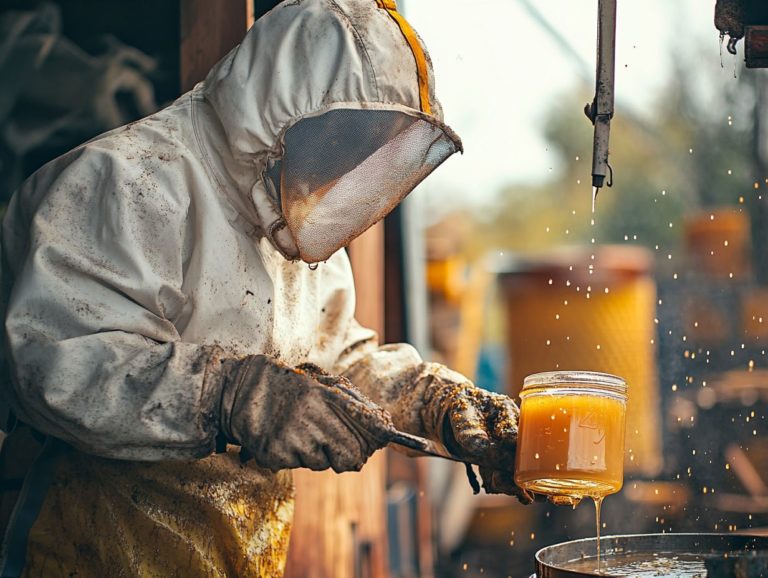The Impact of Equipment on Bee Behavior
Bees are truly remarkable creatures, showcasing complex communication methods that ensure their hives thrive. Through sophisticated chemical signals and intricate dance routines, these tiny insects convey essential information about food sources and hive dynamics.
As you delve into the world of beekeeping, consider how the equipment you use, such as hive tools and bee brushes, can significantly impact bee behavior. This exploration goes beyond mere honey production; it invites you to reflect on how your practices affect the natural space bees inhabit.
This article will guide you through the fascinating ways bees communicate, the effects of equipment on their natural behaviors during pollen collection, and strategies to minimize disruption while maximizing efficiency. Discover the delicate balance between effective beekeeping practices and the well-being of these vital pollinators!
Learn why protective clothing, like bee suits and veils, is crucial for your safety and the bees’ well-being.
Contents
- Key Takeaways:
- How Do Bees Communicate?
- The Impact of Equipment on Bee Behavior
- How Can We Mitigate the Negative Effects of Equipment on Bee Behavior?
- The Importance of Considering Bee Behavior in Equipment Design
- Frequently Asked Questions
- What is the impact of equipment on bee behavior?
- How does equipment affect bee communication?
- What type of equipment has a negative impact on bee behavior?
- How can equipment be modified to have a positive impact on bee behavior?
- What are some examples of equipment that can improve bee behavior?
- How can beekeepers minimize the negative impact of equipment on bee behavior?
Key Takeaways:

- Bees communicate through various methods, including chemical signals and dance, to coordinate tasks and locate resources.
- Beekeepers use equipment to manipulate bee behavior, but it can also have negative effects on their natural communication.
- To mitigate negative impacts, alternative methods and thoughtful equipment design should consider bee behavior and their natural instincts. Incorporating advanced heat shields and other innovative equipment can make a significant difference.
How Do Bees Communicate?
Bees, especially honeybees, have an intriguing and sophisticated communication system that plays a vital role in their survival and colony management. They rely on a blend of pheromones chemical signals that convey essential information and intricate dance movements to share details about available resources, potential threats, and the dynamics within the colony.
For those of you who are beekeepers seeking to enhance honey production and uphold the strength of your colonies, grasping these communication methods is imperative. This knowledge enables you to respond effectively to the needs and behaviors of your bees, ensuring their well-being and productivity.
What is the Role of Pheromones in Bee Communication?
Pheromones are integral to bee communication, acting as chemical messengers that influence nearly every aspect of honeybee behavior and their intricate social structure.
These invisible signals are essential for coordinating activities within the hive and ensuring the colony’s overall health. For instance, alarm pheromones serve as an alert system for worker bees, signaling potential threats and prompting them to protect their hive from intruders or during swarm preparation.
On the other hand, queen pheromones fulfill multiple roles, such as maintaining cohesion within the colony and suppressing the reproductive capabilities of worker bees. This complex interaction helps manage the colony effectively, guiding foraging behaviors, nurturing of larvae, and even dictating the timing of swarming.
It s a fascinating glimpse into the remarkable complexity of social interactions that thrive within the hive.
How Do Bees Use Dance to Communicate?
Bees engage in a truly remarkable form of communication known as the ‘bee dance’, a vital means of conveying essential information about the location of food sources, such as pollen and nectar, to their fellow hive members.
This intricate behavior encompasses various types of dances, with the waggle dance standing out as the most prominent. During the waggle dance, a bee elegantly moves in a figure-eight pattern, executing a unique waggle run; the angle of this run in relation to the sun indicates the precise direction of the food source. The duration of the waggle phase further communicates distance, with longer waggles signaling that the food is found farther away.
By observing these dances, fellow bees can navigate their way accurately to rewarding foraging sites, highlighting the impressive and sophisticated social structure and communication methods that thrive within the hive.
The Impact of Equipment on Bee Behavior
Do you know how your equipment can make or break your beekeeping success? The tools you use in beekeeping play a pivotal role in influencing bee behavior. Different tools and techniques shape the way bees interact with their environment and one another.
Essential items like hive tools, bee smokers, and bee suits are critical for managing your colonies. These tools are necessary when undertaking tasks like opening hives or lifting them.
Recognizing how this equipment impacts bee behavior is vital for cultivating a harmonious relationship with your colonies. A strong relationship ultimately ensures the health and productivity of your bees.
How Do Beekeepers Use Equipment to Manipulate Bee Behavior?

Beekeepers utilize specialized equipment with precision to influence bee behavior. This ensures efficient colony management while optimizing honey production.
They often depend on tools like bee smokers, which release smoke to soothe the bees during inspections. This significantly reduces the chances of aggressive behavior.
Hive tools are critical in your toolkit. They enable you to remove frames and assess the health of the hive with minimal disruption.
These tools not only provide easier access to the colonies but also enhance your ability to communicate effectively with the bees. This communication allows you to interpret their responses to various stimuli, such as during hive inspections or lifting hives.
By mastering these techniques, you can cultivate a harmonious environment within the hives. This results in healthier colonies and increased honey yields.
What Are the Potential Negative Effects of Equipment on Bee Behavior?
While the right equipment is essential for successful beekeeping, it s crucial to recognize that it can also negatively impact bee behavior. This can lead to stress and disruption of their natural activities.
For example, when you wear bee suits, the added heat can cause bees to feel agitated and even aggressive. This heightened stress can disrupt their foraging patterns, which refers to the ways in which bees search for food, and diminish their efficiency within the hive.
The use of chemical treatments for pests also carries risks. Some bees may get stressed from the heat of protective clothing, and exposure to these chemicals could alter their foraging behaviors and communication. This ultimately affects the health of the entire colony.
Changes in their social structures and their ability to thrive naturally can lead to weakened populations and reduced honey yields. It underscores the importance of carefully considering your equipment and treatment options to promote a healthy and productive hive.
How Does Equipment Affect the Natural Behavior of Bees?
The equipment you use in beekeeping can profoundly impact the natural behaviors of bees. It often reshapes their foraging habits, communication styles, and social interactions.
When you wear bee suits, you re not just prioritizing your safety; you might also be altering how bees perceive human presence. This specialized clothing can help reduce their stress levels, promoting calmer and more consistent foraging patterns.
Introducing smokers into the mix can significantly affect bee behavior. The smoke effectively masks alarm pheromones, allowing the bees to act more naturally during hive inspections. Proper smoking technique is essential to minimize stress and ensure the bees remain calm.
These adjustments can create a more productive environment, ultimately enhancing hive health and increasing honey yield. However, it s crucial to remain mindful of potential downsides; excessive disturbances or improper use of tools can contribute to stress within the colony.
How Can We Mitigate the Negative Effects of Equipment on Bee Behavior?
To cultivate a stronger bond between you and your bee colonies, it is crucial to adopt strategies that minimize the adverse impacts of beekeeping equipment on bee behavior.
- Choose the right tools for the task.
- Be mindful of the temperature when wearing protective gear.
- Limit the use of chemical treatments whenever possible.
- Practice gentle handling techniques to reduce stress.
By choosing the right tools and being mindful of your bees’ needs, you can ensure a thriving colony.
What Are Some Alternative Methods for Manipulating Bee Behavior?
Using alternative methods can minimize stress and promote the well-being of your bees. For instance, gentle handling techniques and the use of latex gloves can reduce the chances of allergic reactions and bee stings.
As a beekeeper, you have the opportunity to explore alternative methods for manipulating bee behavior that honor their natural instincts and communication methods.
One effective strategy involves using gentle bee brushes to nudge bees out of your way. This approach is preferable to relying on more disruptive tools that may induce stress and agitation.
By employing these soft-touch techniques, you maintain the tranquility of the colony while accomplishing essential tasks like hive inspections and honey harvesting.
This method nurtures the bees’ natural behaviors and respects their intricate social structures and communication systems. Start nurturing the bees’ natural behaviors today for healthier colonies!
By fostering an environment where bees feel safe, you encourage healthier colonies and promote more vigorous foraging, ultimately leading to a fruitful relationship between you and the bee community.
How Can We Design Equipment to Better Suit Bee Behavior?

Designing beekeeping equipment with a keen understanding of bee behavior can elevate the health and productivity of your colonies.
Incorporating innovative designs, such as advanced heat shields, minimizes stress on your colonies during temperature fluctuations and fosters a healthier environment.
Utilizing tools that enhance communication like specialized frame designs or observation hives with transparent panels allows you to monitor bee behavior and hive activity effectively.
These enhancements aid you in managing your hives more efficiently and promote sustainability within pollinator populations, benefiting the broader ecosystem.
Using protective clothing, such as bee suits and bee veils, ensures your safety while working closely with the bees.
Understanding these behaviors is essential for ensuring that your hives flourish and that your practices harmoniously align with the bees’ natural instincts.
When opening the hive, using a bee brush to gently move bees and a smoking technique to calm them are practical applications of these insights.
The Importance of Considering Bee Behavior in Equipment Design
Taking bee behavior into account when designing your equipment is essential for beekeepers looking to cultivate a harmonious and efficient working environment. This thoughtful approach enhances colony health and boosts productivity, ensuring your beekeeping efforts yield the best results.
How Can Understanding Bee Behavior Improve Equipment Design?
Understanding bee behavior significantly elevates your equipment design, allowing you to create tools that resonate with the natural instincts and communication methods of bees.
By exploring the fascinating ways bees convey information through natural scents and intricate dances, you can craft environments that reduce stress and encourage natural activity.
For example, incorporating vibration sensors or acoustic devices that replicate the sounds bees typically encounter can lead to tools that are less intrusive and remarkably efficient in supporting the bees’ foraging behaviors.
Gaining insights into how bees navigate their hives can inspire innovations in hive designs, ultimately facilitating more effective colony management and improving pollen collection techniques.
This thoughtful integration enhances bee welfare and boosts honey production and pollination efficiency, providing significant benefits to both beekeepers and the wider ecosystem.
What Are the Potential Benefits of Considering Bee Behavior in Equipment Design?
Considering bee behavior when designing your beekeeping equipment can yield a wealth of benefits, including increased honey production and improved colony health. Understanding the significance of propolis a resinous substance that bees use to build and protect their hives in hive structure and defense can lead to better equipment designs.
By crafting tools that align with the natural instincts of bees, you may find that foraging efficiency dramatically enhances. This allows these remarkable creatures to navigate their surroundings with greater ease. Such thoughtfully designed equipment can significantly reduce stressors, enabling bees to concentrate on their vital roles within the hive. Ultimately, this boosts overall productivity. Tools like the bee smoker and hive tool are essential in maintaining a calm and manageable environment, further aiding in honey production and other activities vital to the hive.
When their environments mirror the wild habitats where bees naturally thrive, colonies often feel less threatened, resulting in healthier and more active populations. This thoughtful approach not only creates strong relationships within the hive but also translates into higher-quality honey and sustainable practices that benefit both you as a beekeeper and the pollinators you cherish. Establishing a natural space around your apiary can significantly enhance this effect.
Frequently Asked Questions
What is the impact of equipment on bee behavior?

The impact of equipment on bee behavior refers to how the use of certain tools, devices, or machinery can affect the actions and reactions of bees, either positively or negatively. For example, using high-quality latex gloves can help minimize the transfer of odors that might upset the bees.
How does equipment affect bee communication?
The use of equipment can disrupt the natural communication between bees, as they rely heavily on pheromones chemical signals that bees use to communicate with each other. Loud or vibrating equipment may interfere with this communication and cause confusion among the bees, potentially leading to reduced colony strength and efficiency.
What type of equipment has a negative impact on bee behavior?
Certain types of equipment, such as excessive lighting, loud machinery, and strong scents, can negatively impact bee behavior. These factors can disrupt their natural patterns and cause stress, ultimately affecting their foraging and pollination abilities. Beekeepers should be aware of potential heat stress caused by certain equipment during hot weather conditions.
How can equipment be modified to have a positive impact on bee behavior?
You can modify equipment to have a positive impact on bee behavior by reducing noise and vibrations, using low-intensity lighting, and avoiding the use of strong scents. This allows for a more natural and peaceful environment for the bees. Additionally, you can incorporate a heat shield in hot climates to prevent overheating within the hive.
What are some examples of equipment that can improve bee behavior?
Equipment such as observation hives, bee-friendly landscaping tools, and customized hive designs can improve bee behavior by providing a safe and natural environment for them to thrive. Tools from beekeeping supply shops often include designs tailored for European honeybee behaviors.
How can beekeepers minimize the negative impact of equipment on bee behavior?
Beekeepers can minimize the negative impact of equipment on bee behavior by using it during non-peak hours, incorporating natural materials and designs in their equipment, and regularly monitoring the behavior and health of their bees. Joining beekeeping clubs can provide additional insights and shared experiences on best practices.
Act now to improve your beekeeping practices and boost your honey production like never before!






